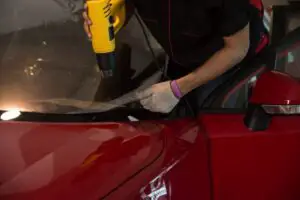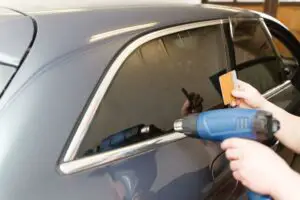Tinting law is a part of state regulations that must be followed as per the law. The same goes for Vermont, which has a set of window tint laws for its residents and vehicle owners.
Vermont being a beautiful state has its perks about the summer. But the heat requires a tint that limits the contacting light from entering.
While for this state, the limitations for all vehicles are slightly different than in other states.
Vermont window tint laws clearly state an AS-1 tint on the windshield, the driver and passenger window should not be tinted, and there is no required tint limitation for the back seat window or the rear view window.
The windshield tint has to be of non-reflective and non-metallic material. The law states, “it is illegal to tint the front two windows entirely”.
This law was updated recently, and there has not been a single change in the prior law.
Attention to the rules and regulations is important if you do not want an ugly or unwanted situation.
Table of Contents
- 1 How Much Tint Darkness Is Legal In Vermont?
- 2 Window Tint Reflection And Tint Colors
- 3 Medical Exemption Of Window Tint Laws In Vermont
- 4 Get A Certified Sticker From The Company
- 5 Other Window Tint Law Rules And Regulations In Vermont
- 6 Cost Of Car Window Tint In Vermont
- 7 Frequently Asked Questions
- 8 Conclusion
How Much Tint Darkness Is Legal In Vermont?

The darkness of the inside of a car is measured by VLT, which is the Visual Light Transmission after applying solar or dyed tint.
If the VLT is lower such as 5%, the car will be very dark, and a 70% VLT tint will allow 70% of contacting light inside.
So for security and safety issues, every state has a limited VLT percentage. In Vermont, it is illegal to tint the front two windows of the driver’s seat and the one adjacent to it.
The windshield can have a tint of non-reflective material according to the manufacturer’s AS-1 line. The back three windows have no such law for any darkness or tint.
Tint Darkness Limit For SUVs And Vans
The state of Vermont is strict in its rules, and they take it as if it has been set in stone. The laws for all multi-purpose vehicles are different than passenger cars.
When it comes to SUVs or vans, the front two windows should not be tinted. It is illegal to tint them. At the same time, the windshield can have a tint as per the manufacturer’s AS-1 line.
For the back seat windows and the rearview windows, there are no such requirements by state law. The back three windows can be tinted to any darkness desired by the driver.
SUVs and vans harbor many passengers at once. That is why their security clearance is as important as keeping the car glare-free for the passengers.
Tint Darkness Limit For Sedans
If you have a sedan for daily use, in summers the sun makes the car very hot on the inside. The easy way to cool down your car is to tint it.
For any passenger car, the Vermont automotive window tint regulation is specific and clear.
1. Front Windshield
The windshield has a three to four-inch area on top, usually tinted, apart from reflective, metal, or mirrored. An AS-1 line tint is allowed.
2. Front Seat Side Windows
The front seat windows of the driver and front passenger are illegal to be tinted at all. It needs to allow a 100% contact light through.
3. Rear Window
According to the state law of Vermont, there are no requirements for rear window tinting. It can be of any darkness.
4. Back Seat Side Windows
Like the rearview window, the back seat windows do not have any specific rule for tinting and can be any dark.
Window Tint Reflection And Tint Colors
- One of the oldest window tinting laws permits tint of the back three windows and the AS-1 line of the windshield.
- The AS-1 tint of the windshield cannot be of any reflective or metallic material.
- While the front windows are prohibited from tinting and are illegal, the other tinted windows should not be reflective, mirrored, or of a metallic material.
- Vermont has no restrictions on the color of any chosen tint.
- The tail lights being tinted are also illegal in Vermont state law.
Medical Exemption Of Window Tint Laws In Vermont

Unlike some states that do not allow medical exemptions on the window tint, Vermont’s tint rule is considerate enough to provide the exemption if the authorities approve a medical case.
It is included in their law and can be pleaded civilly through a proper channel.
If a medical condition that restricts your movement in the sun or makes it difficult to drive in the sun is put forward, the procedure is straightforward.
An online medical exemption form will have to be downloaded and filled in accordingly. The form will be shown to your registered physician or optometrist.
Once the claim and the form are authorized, it has to be taken to the Agency of transportation- department of motor vehicles.
If your medical exemption application is approved, the agency will provide you with a permit and a certificate with an affixed percentage of VLT tint for your front windows, which will have to be renewed after four years.
Get A Certified Sticker From The Company
The state keeps everything under check and balance, the manufacturers are already provided the permitted tinting law, and they are assumed to abide by it.
Therefore, the manufacturer does not provide its customers with certifying stickers to prove the legality of the tint. Thus, there is no requirement for stickers on the tinted window.
If your medical exemption application is approved, the department of motor vehicles will provide you with a permit for a fixed specified special percentage of front window tints.
The certificate is effective for four years and should be present in the car.
Other Window Tint Law Rules And Regulations In Vermont
This section will discuss a few points that are secondary but as important as the major rulings of the window tint law.
- The law dictates clear indications for no front window tinting. It is illegal.
- No metallic or reflective material should be used as the tint film.
- The tail lights should not be tinted.
- If the rearview window is tinted, there is a requirement for dual, untinted side mirrors.
- No certifying ticker is required on the tinted window.
This section has all the major and minor rules and regulations to better understand what to do and what not to do.
Cost Of Car Window Tint In Vermont
If you want to save a few hundred bucks, then directly order the DIY set from the internet that costs $100 and tint your windows yourself.
But if you need a professional at its best, then in Vermont, it can cost about $150 for starters and can lead up to $400.
Frequently Asked Questions
Q1. Is 15% Tint Legal In Vermont?
No, the front windows should be untinted. But the back windows can be of any darkness. So 15% is legal for back windows only in Vermont.
Q2. Are 5% Tints Legal In Vermont?
This darkness is not even allowed on the medical exemption for front windows. The back windows, however, can have this tint.
Q3. Is Limo Tint Legal In Vermont?
No, this darker tint is not acceptable in Vermont as limo tint is a darker one. This tint can be used in back windows and rearview windows.
Q4. Can I Get Pulled Over For Tint In Vermont?
If you have an illegal tint on your windows, the police will pull you over for a minor misdemeanor or breach of law.
Q5. How Much Is A Tint Ticket In Vermont?
If you are charged for an illegal tint, the ticket can be as little as $47 or as high as $1,197, depending on the frequency of tickets.
Conclusion
The Vermont tint laws are one of the oldest laws for window tinting and have been updated regularly for any inconveniences.
The no-tint on front window law is strict and will not be tolerated. At the same time, the windshield can have an AS-1 line tint.
Furthermore, the law has medical exemptions for those who need it. The summertime in Vermont is a beautiful green time, but it also has long sunlight hours and heat waves.
Tints are important, but they should be by the law. Any inconvenience should be taken up with the state law enforcement agency.

I am Tahir Azam, and I have been writing amazing articles for TaxiHack for as long as I can remember. I know everything that is to know when it comes to automobiles and is always on top of industry news and developments. While I am not an expert by any means, I pride myself on knowing the ins and outs of many different problems and, of course, their solutions. The articles on our website are some of the best and well-researched content that you will find, and I spend countless hours making sure this remains to be true. This is why I ask you to take your time out and read some of my articles, especially if you find a topic that resonates with you or is something you are looking into. This way, you will find the perfect mix of information and tips on your desired topic. Learn more about Tahir.



